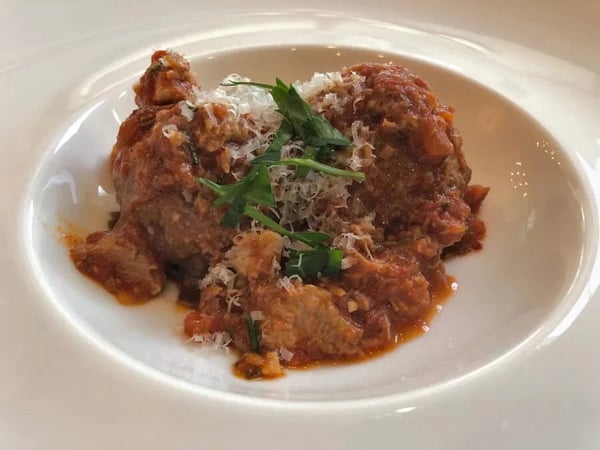In part 3 of this series, we will focus on the third Mother Sauce: tomato sauce. Tomato sauce is one of the Mother Sauces that many people actually do make at home, and it's also one of the few sauces you can find a delicious version of in a jar. I think people make tomato sauce because they love tomato sauce, and it also doesn’t have a complex thickening technique.
This leaves me with a challenge: what tips can I give you for making tomato sauce that really compels you to elevate your tomato sauce game? What can I share with you that would really escalate the texture and flavor of your tomato sauce? I'm going to focus on the same two techniques we focused on in part 1 and part 2 of this blog series: developing flavor and texture.
Classic sauce or ragout on meatballs
Developing Flavor
In our Flavor Dynamics class, we focus on the five different tastes, we review the difference between taste and flavor, we talk about mouth feel and sensory stimulation and how that effects our overall satisfaction in what we eat. I think tomato sauce of all the Mother sauces is where this is best exemplified. A tomato naturally has three of the five flavors: sweetness, acidity and umami. The trick to a flavorful tomato sauce is to balance or accentuate those three flavors. I’m sure you are aware that when you purchase a fresh tomato at the grocery store in Chicago in February that it isn’t going to taste very tomato-y. If I want my tomato or my tomato sauce to taste more tomato-y, how am I am going to do that? I am going to bump up the sweetness, acidity and umami. No matter how good your fresh or canned tomato is, you are going to have to bump up the flavor. The list below are some of the ingredients we rely upon to do that.
1. Sweetness: I don’t want my tomato sauce to taste sweet. I think most people would agree, and that is what stops them from adding something sweet to their tomato sauce. The goal here is to have a balanced sauce that tastes like tomato and not a sweet sauce.
- The first technique in developing sweetness is to cook the tomatoes. Think of cooking as simulating a ripening process - when you cook a fresh tomato it intensifies it and sweetens it. Canned tomatoes are already cooked so that process is halfway there.
- Sugar might be the most common way to sweeten tomato sauces. Sugar adds a direct pop of sweetness. Be sure to add small quantity at a time and taste after each addition so that you don’t end up with a sweet sauce.,
- Fruit and carrots are a very natural way to add mild sweetness, and carrots are my personal favorite for this. Peel them, dice or grate them and add them to your sauce. They can be pureed or left chunky. Fresh pears, dried apricots, currants or raisins can also be used the same way.
2. Acidity: We don’t want our tomato sauce to taste too acidic either. Again, the point here is to bump up the acidity but in a balanced way.
- Wine is commonly used and easily incorporated into tomato sauce. Preferably white wine as red doesn’t add much in the way of acidity and can create an unpleasant color. Make sure to cook off the raw wine taste by cooking it for at least 5 to 10 minutes.
- Vinegar is a chef's best friend and one of the secrets to complex and exciting flavors. The key is to start with a good quality vinegar which I discussed in part 1 of this series and to make sure it is completely cooked off. You shouldn’t sense vinegar is in the dish other than the complexity it leaves behind. If I use vinegar, I am generally adding it to a long cooking sauce and at the beginning of cooking.
- Citrus, typically lemon, would be used at the end of cooking since the acidity of citrus can cook out quickly. When you either want the fresh taste of citrus, need a little acidity correction at the end of cooking or are making a quickly cooked tomato sauce, lemon is great.
- Olives and capers are often used in tomato sauce. They not only add salt but acidity.
3. Umami: Umami is an earthy component; we often associate the flavor with a great steak or piece of cheese.
- Tomato sauce often has either meat added to the sauce itself or has had pork bones, prosciutto ends, salt pork, sausage or ground beef simmered in the sauce during cooking. All of these punch up the umami flavor.
- Anchovy paste or Parmesan cheese rinds are secret weapons in tomato sauce. Again no one will likely know they are there, but they will wonder why your sauce is so intensely good!
- Mushrooms are a great vegetarian option for bumping up the umami.
- Tomato may sound funny to add to tomato but adding tomato paste, sun-dried tomato or even some canned tomato to a fresh tomato sauce can bump up the tomato volume.
In addition to enhancing the natural flavors of tomato to boost the flavor of your sauce, there are a couple more really important flavor-enhancing techniques everyone should know.
1. Evaporation or reduction is something we discussed in part 2 of this series so I don’t want to be redundant, but I felt I would be remiss in not mentioning it again. Tomato sauce deepens and intensifies the longer you cook it. Tomato sauces can be cooked in 10 minutes or for 4 hours, and they can all be delicious. Cooking sauces for a long time don’t inherently make them better, but it does intensify the flavor.
2. Aromatics such as Soffritto, Mirepoix, the Holy Trinity and Refogado create a base flavor in sauces, soups, stocks and cooking at large. I could write an entire blog on this significant and foundational subject. Today however I have to keep the focus on tomato sauce and how soffritto is used to build flavor in it.
I think of Soffritto as an aromatic blend of vegetables that are chopped relatively small, sautéed and used as the foundation or flavor base for your sauce. Tomato sauce is most often thought of for pasta and Italian dishes but it is used internationally. In Italian style sauces, the base or Soffritto is generally made of garlic, onion and parsley but may have meat, lard, celery, carrots or peppers as well. In Chinese cooking, they might use ginger, scallion and garlic. In Cajun or Creole cuisine, the Holy Trinity would include green pepper, onion and celery. In Portuguese cuisine, their Refogado would likely include garlic, onion, saffron and smoked paprika. In French cooking, the classic Mirepoix is onion, carrots and celery. Learning how to change the flavor profile and the texture of your sauce can help you achieve authentic results as you branch out into other cuisines.
.jpg?width=600&height=426&name=vegan-lasagna-with-concasse-style-sauce%20(1).jpg)
Vegan lasagna with Concasse-style sauce
Textures
Choosing the texture of your tomato sauce is a massive opportunity for elevation, and I want to share a few tips on how to take control of the texture of your sauce. There isn’t just one desirable texture for tomato sauce, but what I want to share with you is how to achieve the three different bodies of tomato sauce that represent three vastly different textures and tastes.
- Concasse or Crudo style sauce: Small chunks of tomato in a light tomato sauce. Great for vegetable and fish focused dishes or dishes you want to lighten up such as vegetable lasagna, poached eggs or fish or grilled chicken.
- Coulis style sauce: Texture of velvet, light and delicate but rich. It's more creamy and buttery than richly tomato. Great to enrichen and elevate any protein or vegetable dish.
- Classic Tomato Sauce, Ragout, Gravy, or Meat Sauce: A thick and deeply tomato sauce often made with meat. Serve over pasta, in lasagna or for Moussaka.
Concasse-Style Tomato Sauce
2 ounces olive oil
1 to 2 garlic cloves, minced
1 shallot, minced
2.5 pounds beef steak or heirloom tomatoes, peeled, seeded and diced
1/2 cup dry white wine
Pinch of fresh-cracked black pepper
Salt to taste, approximately 1 to 2 teaspoons
Sugar to taste approximately 1/2 to 1 1/2 teaspoons
1 to 2 tablespoons fresh herbs such as parsley, basil, tarragon, chervil or dill
Over a low to moderate heat, saute garlic and shallot in olive oil just until you can smell the garlic. Add tomatoes and white wine and simmer for at least 5 minutes but up to 20 depending on how much you want to reduce and intensify flavors. Season to taste with pepper, salt, sugar and herbs.
Coulis-Style Tomato Sauce
2 Tablespoons olive oil
2 Tablespoons butter
2 garlic cloves, minced
1 shallot, minced
2 pounds Roma tomatoes, peeled, seeded diced
1/3 cup dry white wine
Salt to taste, 1/2 to 1 teaspoon
Sugar to taste, 1/4 to 1/2 teaspoon
2 Tablespoons fresh herbs such as parsley, basil, tarragon, chervil or oregano
Over a low to moderate heat, saute garlic and shallots in olive oil and butter just until you can smell the garlic. Add tomatoes and white wine and simmer for at least 10 minutes but up to 30 minutes. Puree in blender until velvety smooth. Season with salt, sugar and herbs to taste.
Classic Tomato Sauce
Note: If you would like to leave the meat out of this sauce, saute the onions, garlic and carrots in 2 Tablespoons of olive oil and 3 tablespoons of butter.*
1 - 2 Tablespoons olive oil
1 - 2 Tablespoons butter
1/2 to 1 pound pork neck bones, pork or beef rib or shoulder meat cut in 1 inch cubes, Italian sausage or ground beef
Soffritto: If using ground meat, no meat or mushrooms, mince your soffritto finely.
I medium onion, peeled and diced small
1 large carrot, peeled and diced small
2 - 3 cloves of garlic
2 Tablespoons fresh oregano, minced
2 28-ounce cans whole canned tomatoes
3 bay leaves
Salt, to taste
Heat a stock pot over moderate to medium high heat and add olive oil and butter. Add meat and brown thoroughly. Remove meat from pan and add diced onion, carrot and garlic and saute for about 5 minutes. Add oregano, tomatoes and bay leaves and return meat to the pan. Cook from 30 minutes to two hours or until meat is cooked and desired texture and intensity is achieved.
If using cubes of meat remove those and shred. Mash the sauce with a potato masher and add the meat back in. Season with salt to taste.
*Animal fat not only adds flavor but also a pleasing mouth feel or texture. These sauces' texture can be made richer if you choose by adding butter or heavy cream at the end.
The whole idea of a Mother Sauce is that they are base sauces and once you learn how to make one of them, such as Tomato Sauce, you have the foundation to make all tomato sauces. I think that idea is both simplifying and terrifying to most people. The idea that once I learn to make a Bechamel or white sauce, which I will be discussing in part 4 of this series, any white sauce can be made from that recipe seems somewhat insane!
These three types of tomato sauces represent a very small array of the different types of tomato sauces you can make, but I hope it gives you a little more direction than providing just one basic style. If you’re interested in learning more on how to unlock the flavor in your food, check out our essential Flavor Dynamics class. If your interest is more in tomato and Italian sauces, our Pasta Workshops are incredibly popular.
If you want to work on becoming sauce savvy at home, download our How to Make Great Sauces which includes even more tips on making the classic Mother sauces, plus a slew of modern sauces.
I would like to emphasize that tomato sauce can be incredibly personal to a family. There isn’t anything that honors me more than when students and friends share their family's tomato sauce recipes. I would be thrilled if any of you would share those now in the comments. I know everyone who reads this blog would love to hear your tips and tricks to your favorite tomato sauce.













